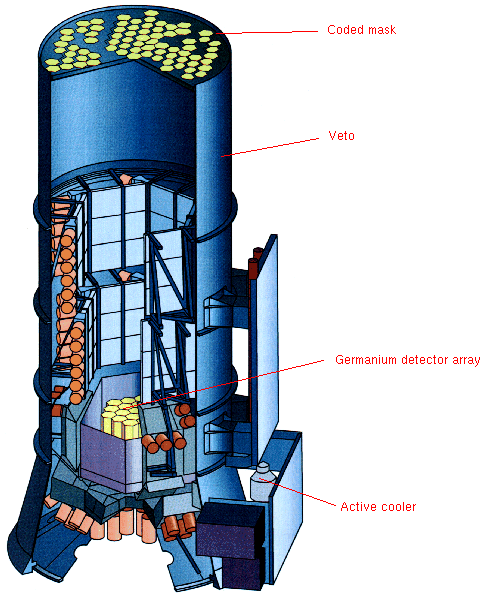Instruments SPI - INTEGRAL
SPectrometer on INTEGRAL: SPI
Jean-Pierre Roques, CESR Toulouse, France
Jochen Greiner, MPE Garching, Germany
with collaborating scientific institutes in France (CESR Toulouse, CEA Saclay, CNES Toulouse), Germany (MPE Garching), Italy (INAF/IASF-Milano), Spain (U Valencia), Belgium (U Louvain), United Kingdom (U Birmingham), USA (UC San Diego, LBL Berkeley, NASA/GSFC Greenbelt).
The spectrometer SPI (SPectrometer on INTEGRAL) performs spectral analysis of gamma-ray point sources and extended regions in the 18 keV - 8 MeV energy range with an energy resolution of 2.2 keV (FWHM) at 1.33 MeV. This is accomplished using an array of 19 hexagonal high purity Germanium detectors cooled by a Stirling cooler system to an operating temperature of 85 K (15 are currently operational). A hexagonal coded aperture mask is located 1.7 m above the detection plane in order to image large regions of the sky (fully coded field of view = 16°) with an angular resolution of 2.5°. In order to reduce background radiation, the detector assembly is shielded by a veto (anticoincidence) system which extends around the bottom and side of the detector almost completely up to the coded mask. The aperture (and hence contribution by cosmic diffuse radiation) is limited to ~ 30°. A plastic veto is provided below the mask to further reduce the 511 keV background.
For more details we refer the interested reader to ISOC's Announcement of Opportunity documentation of the SPI Observer's Manual and to a sequence of papers on the SPI payload in the A&A Special Letters issue on: First science with INTEGRAL. This issue also contains various other papers on the first results from in-flight observations. For descriptions of the SPI data analysis we refer to, e.g., Diehl et al. (2003, A&A 411, L117), Skinner & Connell (2003, A&A 411, L123) and Strong (2003, A&A 411, L127). The validation reports of the ISDC Off-line Scientific Analysis (OSA) software package released by the ISDC for SPI, as well as descriptions of the data analysis pipelines and modules and the use of the OSA software can be found at the ISDC website (https://isdc.unige.ch/integral/analysis#Documentation).
Spectrometer SPI page at MPE Garching, Germany
Spectrometer SPI page at IRAP, Toulouse, France
Overview of scientific capabilities of SPI
| Energy range | 18 keV - 8 MeV |
| Detector area | 500 cm2 (Ge - Germanium) |
| Spectral resolution | 2.2 keV FWHM @ 1.33 MeV; E/ΔE=~450, for each detector |
| Field of view | fully coded: 14° flat to flat, 16° corner to corner zero coding (zero sensitivity): 32° flat to flat, 35° corner to corner |
| Angular resolution (point sources) | 2.5° deg (FWHM) |
| Point source positioning | <1.3° for point sources (depending on point source intensity) |
| Continuum sensitivity* | 8.8e-4 ph/(s cm2 MeV) [3σ in 10e6 s, @ 1 MeV, ΔE = E/2] |
| Narrow-line sensitivity* | 2.4e-5 ph/(s cm2 [3σ in 10e6 s, @ 1 MeV] 4.6e-5 ph/(s cm2 [3σ in 10e6 s, @ 511 keV] |
| Timing accuracy (3σ) | 0.129 ms |
| Resources (following EID-A allocation): | |
| Mass | 1309 kg |
| Power (sun/eclipse) | 385/110 W |
| Data rate | 45 kbps |
* The sensitivities are based on in-flight background measurements.
Back to the INTEGRAL Scientific Payload page
- Removed a total of (2) style text-align:center;
- Removed a total of (1) align=right.
- Removed a total of (2) border attribute.








































 Sign in
Sign in
 Science & Technology
Science & Technology
